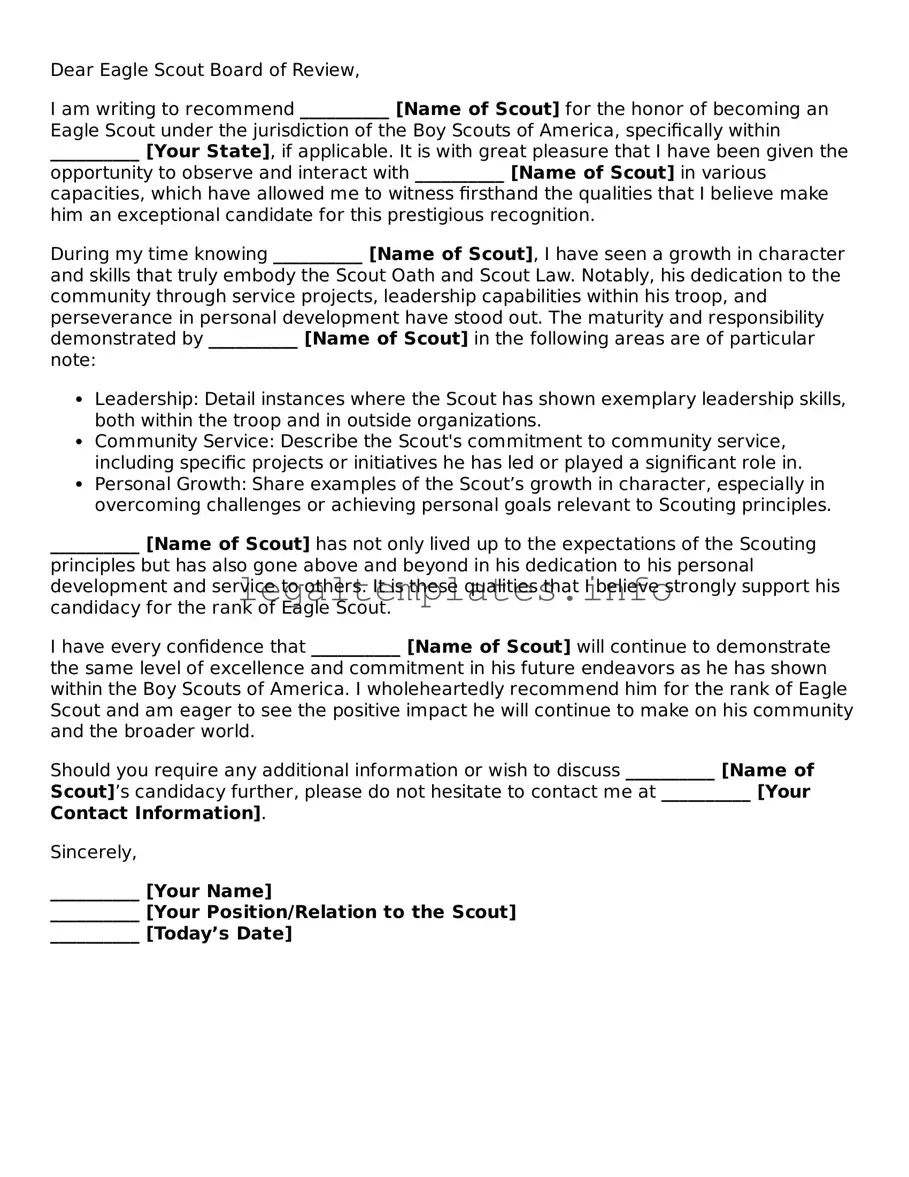The Eagle Scout Letter of Recommendation form is similar to a College Recommendation Letter, as both serve the purpose of endorsing the applicant to a decision-making body. In a College Recommendation Letter, a teacher or counselor vouches for the student's abilities and character, aiming to enhance their college application. Like the Eagle Scout recommendation, it provides a personal insight into the applicant's qualities and achievements, offering a comprehensive view beyond grades and test scores.
It also bears resemblance to a Job Reference Letter, which an employer or colleague writes to recommend a candidate for a specific job position. This letter outlines the candidate's work ethic, skills, and contributions to the workplace, mirroring the Eagle Scout form’s goal of presenting the candidate's abilities and personal traits. Both documents aim to influence the recipient's opinion positively, thereby increasing the candidate’s chances of success.
A Graduate School Recommendation Letter is another document that shares similarities with the Eagle Scout Letter of Recommendation. This type of letter supports an applicant's admission into a graduate program, highlighting their academic accomplishments and potential for success in a rigorous academic environment. Similar to the Eagle Scout recommendation, it often includes personal anecdotes or examples to illustrate the candidate's qualities, providing insight into their character and capabilities.
Similar to a Military Recommendation Letter, the Eagle Scout Letter of Recommendation plays a crucial role in a candidate's application process. The Military Recommendation Letter supports an individual’s application to a military academy or for a particular military honor, focusing on leadership, integrity, and physical fitness. Both letters aim to portray the candidate’s suitability for an honor or position, underscoring qualities such as leadership and commitment.
The Eagle Scout Letter shares characteristics with a Character Reference Letter for Court. This document is used in legal proceedings to highlight a defendant's positive attributes, potentially influencing the outcome. Like the Eagle Scout recommendation, it informs the reader about the individual’s character, aiming to present them in a positive light and impact decision-making in their favor.
A Scholarship Recommendation Letter is also akin to the Eagle Scout Letter of Recommendation. This form of endorsement supports a student’s application for a scholarship by detailing their academic abilities, extracurricular involvement, and personal characteristics. Both documents aim to secure an opportunity for the candidate, relying on the recommender's personal testimony to their qualifications and potential.
A Professional Membership Application Letter of Recommendation is another document with similarities to the Eagle Scout form. When applying for membership to professional societies or organizations, applicants often need a recommendation to vouch for their professional skills and contributions to the field. Like the Eagle Scout recommendation, it supports the candidacy by highlighting the individual’s achievements and suitability for the membership.
The Eagle Scout Letter of Recommendation resembles an Immigration Reference Letter, which is provided during the immigration process to support an applicant's case for residency or citizenship. This letter speaks to the individual’s character, standing in the community, and contributions to society, much like the Eagle Scout letter aims to display the candidate’s virtues and societal involvement.
Lastly, the Eagle Scout Letter parallels a Board Position Recommendation Letter. This endorsement is crucial for someone pursuing a position on a board of directors, emphasizing leadership skills, financial acumen, or specific expertise relevant to the board's activities. Both documents focus on painting a comprehensive picture of the candidate’s qualifications and readiness for a position of responsibility and trust.
